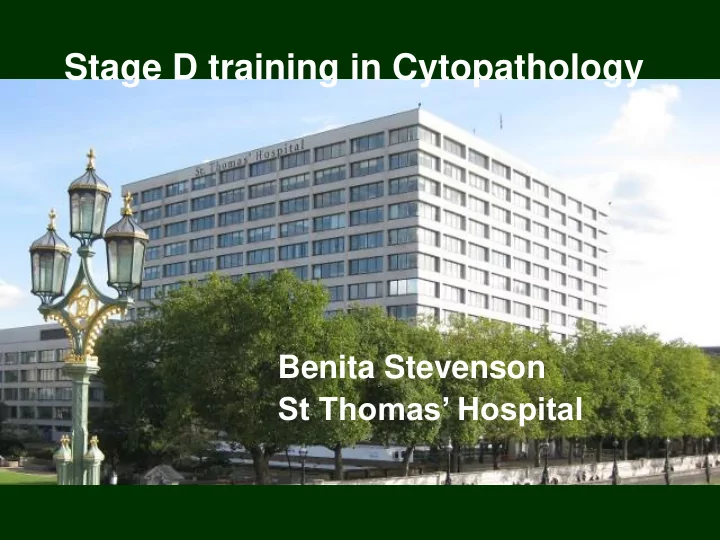

Stage D training in Cytopathology Benita Stevenson St Thomas’ Hospital
Background • Current training 60-66 months depending on additional modules • Stages A – D – ST1/stage A [12mths] (500 surgicals, 150 cervical and 150 diagnostic) – ST2/stage B [12mths] (750 surgicals, 200 cervical and 200 diagnostic) – ST3/stage C [24mths] (1000 surgicals, 300 diagnostic) – ST4/stage C (1000 surgicals, 300 diagnostic) – ST5/stage D [12 mths] (1500 surgicals, 300 diagnostic) • Stage D – post-exam – 12 months
Advanced cytopathology training • Cytology component of standard stage D: – 300 cases • Subspecialty training in Cytopathology – Introduced in 2007 curriculum – Replaced diploma in cytopathology – Poor uptake
Subspeciality training in Cytopathology • Competency-based training – no formal final examination • Assessment – summative portfolio – WBPAs
Aims (1) • Competencies of a specialised cytopathologist • Act as local lead – Advise clinical colleagues on sampling taking and submission – Knowledge of ancillary testing – Teaching experience in workplace and formal settings – Function in a MDM setting • Diagnose majority of cytology samples independently – Manage non-correlation between cytology and other investigations including histology and colposcopy
Aims (2) • Report in a ‘rapid diagnosis’ one -stop clinic setting • Perform fine needle aspirates (FNAs) • Detailed knowledge of NHSCSP – Interpret quality assurance data – Interpret performance indicators
Entry to programme • Satisfactory completion stages A-C with FRCPath Parts 1 and 2 in histopathology Cervical cytopathology 3 months equivalent (stage C or D) 500 cervical cytology cases, majority new screening cases 4 x WBPA (all directed) CHCCT exam
Subspecialty training in Cytopathology • Structured educational programme • Stage D entirely within cytopathology – whilst continuing to accumulate the histopathology competencies for completion of Stage D • Broad scope
Components Reporting Technical skills 12 months equivalent 1000 gynae cytology cases, 15 x FNA clinics majority new screening cases 1000 diagnostic cytology cases, appropriate mix of specimen sites 15 x endoscopic US-FNA clinics and types
Assessment 18 WBPA 12 directed Structured case-log Training portfolio FNA experience Endoscopic US-FNA experience EQA performance Colposcopy MDM experience Personal performance monitoring data Cervical cancer audit case Histopathology/cytopathology correlation cases Critical review of errors Educational supervisor’s report ARCP outcome 6
WBPAs (1) DOPS Perform FNA using an aspiration technique Perform FNA using a non-aspiration technique Spread and stain a direct smear from an FNA Assess adequacy of a targeted aspirate from a deep lesion CBDs Provide second opinion/review on a case previously reported Discuss a case where morphology and ancillary studies give inconclusive results Discuss a case assessed in a rapid diagnosis clinic where an immediate report was not appropriate Discuss a case where ancillary studies were essential to the diagnosis
WBPAs (2) ECEs Present a non-cervical case at an MDT where there are discordant cytological findings Discuss statistical data prepared for KC61 returns Audit and present cytology performance in an area of specialist practice Explain procedure and take consent for a fine needle aspirate
Our experience • Based at St Thomas’ Hospital • 35000 gynae cases/yr • 6500 non- gynae cases/yr
Cytology service at St Thomas’ • Eight consultants • Daily ‘on - call’ rota – Same day service for urgent samples – Wet preparation • cross-polarisation • phase contrast microscopy – Immunofluorescence – Triage of needle washings for ancillary testing
My role • Clinical service duties – Review and interpret most specimens – Progressive responsibility for caseload – Performing FNAs of palpable lesions – Performing ROSA for FNAs – Selection and interpretation of ancillary studies – On-call responsibility – Supervising consultant available at all times
FNA experience • Utilising both aspiration and non-aspiration techniques • Experience of multiple environments: – Wards – ITU – Theatres – Dedicated ‘palpable lump’ clinic • Impact of imaging – Difficulty gaining numbers – Opportunity to collaborate
ROSA (1) • Rapid on site assessment – urgent ward FNAs – U/S guided H+N clinics – EBUS clinics
ROSA (2) • Adequacy – Time vs risk of false -ve • Communication • Ancillary testing – Small samples
Other responsibilities (1) • Multidisciplinary meetings – lead colposcopy MDMs – presented at other relevant MDMs (thyroid, H+N) • Teaching – Attend and assist in weekly FNA teaching – Formal teaching slot • departmental teaching/blackbox rota • ST1 teaching week
Other responsibilities (2) • EQAs – Continuing participation in gynae cytology EQA • Management – First port of call for technical and clinical questions from BMS, screeners and clinical staff – Monthly consultants cytology meeting
Subspecialty training in Cytopathology Pros Cons Wide spectrum of caseload Double the assessments ‘Hands on’ practical experience Gaining FNA numbers Different preparations and techniques Maintaining histopathology skills No peer group support to compare Managing small volume samples progress Exposure to different work practices
Stage D assessment pathways Histopathology Cytopathology 1500 surgicals (dependent on - specialist interest/complexity) 300 diagnostic cytology (suggested) 1000 diagnostic cytology 1000 gynae cytology 12 x WBPA 18 x WBPA 1 audit 1 audit Multisource feedback Training Logbook CCT in Histopathology & CCT in Histopathology Cytopathology
What could be improved? • Collaboration with radiology for FNAs – Difficulty of FNA experience – Training of ultrasound-guided FNAs • more controversial • not on curriculum • Access to molecular attachment – Now on new curriculum
Conclusion • Excellent opportunity – Technical skills – Diagnostic proficiency • Managing cytological-histological discordance • Recognising sampling and diagnostic limitations • Correlating clinical & imaging data with ancillary testing to provide a robust diagnosis • Seeking senior consultation from others • ….but a lot of work!
References 1. Curriculum for specialty training in histopathology. Royal College of Pathologists, June 2015 https://www.rcpath.org/resourceLibrary/histopathology- curriculum--2015-.html 2. Curriculum for specialty training in histopathology. Royal College of Pathologists, June 2010 https://www.rcpath.org/resourceLibrary/histopathology- curriculum---2010-.html
Recommend
More recommend